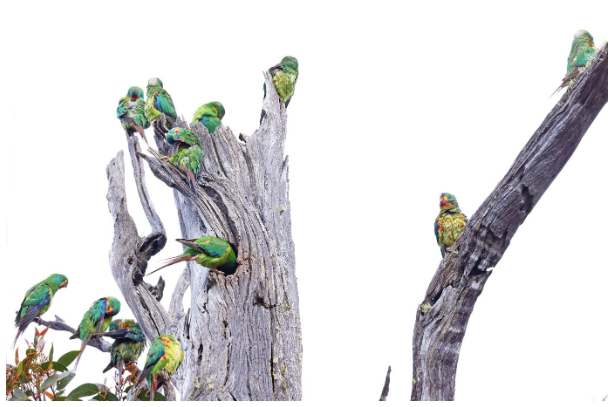Today the swift parrot is listed as Critically Endangered under the Commonwealth’s Environment Protection and Biodiversity Conservation (EPBC) Act 1999. It is estimated that there are 750 birds remaining in the wild, with that number declining year by year.
I spent most of last summer climbing trees to photograph swift parrots, specifically in two logging coupes in the Eastern Tiers in Tasmania.
One of these forest areas, SH050B, was by far the most important observed swift parrot site in Tasmania in the summer of 2022/23. It was simply spectacular. There was one confirmed nesting site and almost certainly more that were undetected. Flocks of up to 30 parrots were observed on several occasions, with 12 birds photographed on a single branch. Flocks of 6 to 20 birds were routinely observed.
Forestry Tasmania logged this forest in June and July this year. They left the identified nest tree, with a small buffer, but the entire area where the parrots were primarily active, and where most observations and records to Tasmania’s Natural Values Atlas were made, was logged.
If Forestry Tasmania had set out to inflict the maximum damage on the 2022/23 swift parrot breeding population they could not have chosen a more devastating way to do so than by logging SH050B.
Ecologist and swift parrot expert Dr David Milledge notes that the system of logging that has been applied to SH050B, was “fundamentally unsustainable with regard to Swift Parrot conservation. The large, old trees containing the hollows required by the parrots for nesting had mostly been felled…resulting in a highly modified forest community devoid of old-growth elements and resembling a plantation in structure.”
Swift parrot expert Dr Matthew Webb has stated that “the continuation of logging of the swift parrot’s habitat (feeding and nesting) will lock the species into extinction. Without its habitat, all other threats the species faces become irrelevant.”
Under the Tasmanian RFA the logging industry is exempt from the national environment laws that would otherwise protect breeding and foraging habitat of the swift parrot. Forestry Tasmania, whose core business is to log forests, currently determines the fate of this Critically Endangered species. The fox is in charge of the hen-house!
Beyond the impact of the logging itself is the heightened risk of predation by the introduced sugar glider. Swift parrot researcher Dejan Stojanovic notes that “sugar gliders seem to tolerate or even benefit from logging, and they occupy lots of the remaining habitat in disturbed forests. When the swift parrots turn up for their annual breeding season, those little pockets of habitat are full of their main nest predators. It’s like a perfect storm: deforestation destroys the available breeding habitat for swift parrots and pushes them into places where they’re more likely to interact with sugar gliders. As a result, they’re more likely to die. So there’s two threatening processes there which act in synergy…”
Tanya Plibersek is currently undertaking a review of Australia’s national environment laws. For the Swift Parrot and a host of other species to survive, the logging industry needs to be comprehensively brought within the ambit of those new environmental laws.
Logging is incredibly destructive of native forest ecologies. The swift parrot is our canary in the coalmine. Beyond that species is a grim procession of wildlife – Tasmanian masked owls, wedge-tailed eagles, the blue-winged parrot and countless invertebrates that are being frogmarched by logging towards extinction. New Zealand ended native forest logging decades ago, and WA and Victoria are now following suit.
It’s time for Tasmania to recognise the urgency of the entwined biodiversity and climate crises and do the same.

